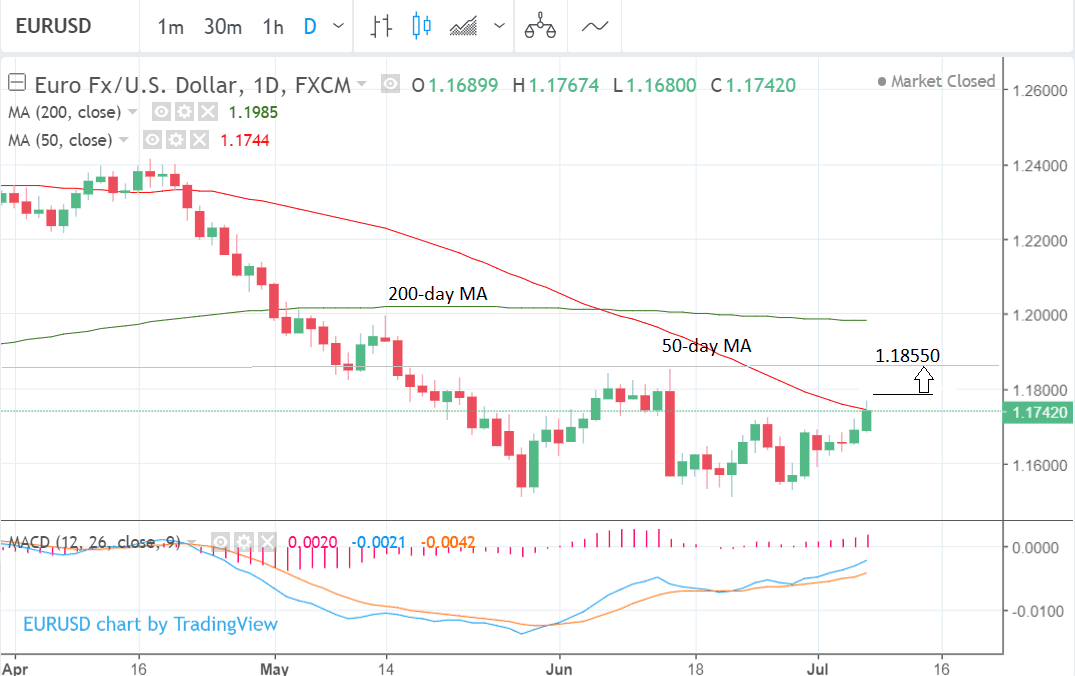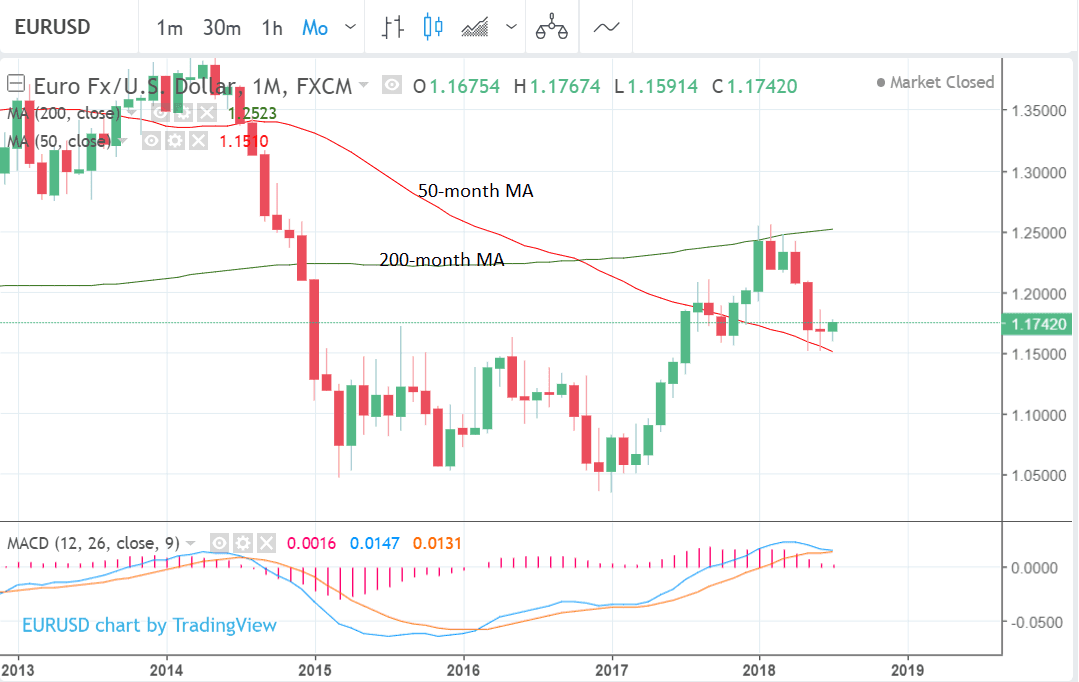EUR/USD Week Ahead Forecast: Caught Betwixt and Between Opposing Forces
- Euro-to-Dollar rate's recovery meets overhead resistance in the 1.17s
- Needs to break clear for confirmation of a continuation of the rebound
- The main release for the Euro is the minutes of the June central bank meeting; for the Dollar inflation data will be a priority.

Image © OkFoto.it, Adobe Images
The Euro laboured higher at the end of last week after trade war risks and disappointing wage data weighed on the US Dollar and European bankers talked up the Eurozone economy.
Although analysts parrot the risks of a trade war it is unclear to whom?
Increased trade war risks, for example, can arguably both hurt and help the Dollar depending on what school of thought you belong to.
Economists are divided over what the trade war means, for example analysts at ING have always held that a trade war would be bad for the Dollar because it would hit US economic growth; those at Commerzbank believe the opposite, and that falling imports would help the Dollar.
What is more certain is that the threat of Trump imposing a 25% tariff on EU cars, however, would most likely hit the Euro harder than the Dollar, and remains an ever-present risk for the Euro.
Even if the EU were to retaliate, the US's trade deficit with Europe would count in its favour; not the Euro's.
From a technical perspective, EUR/USD's recovery in June has now hit a tough wall of resistance in the form of the 50-day moving average (MA), and basically run aground.
It will be difficult for it to break through the 50-day MA; more often than not prices lose in an encounter with a major MA. Short-term traders anticipating the rebuttal moreover magnify the effect by shorting the pair at the same time. This explains last week's neat close coinciding flush with the level of the MA on Friday evening.
Despite the impediment of the MA the short-term trend is up and therefore likely to continue and presents us with contradictory evidence.
The monthly chart presents further evidence in support of bulls as it shows the recent rally which took off in June gaining substantial underpinning support from the even more powerful 50-month MA at 1.1510.
The contradiction of bullish backdrop and bearish short-term risk would resolve itself in a clear break higher, confirmed by a break above 1.1775 with the next target at 1.1850, just below the R1 monthly pivot at 1.1855.
Advertisement
Get up to 5% more foreign exchange by using a specialist provider to get closer to the real market rate and avoid the gaping spreads charged by your bank when providing currency. Learn more here
Data and Events to Watch in the Week Ahead for Euro
The most important release for the single currency in the week ahead is probably the minutes from the European Central Bank (ECB) meeting out on Thursday, July 12 at 11.30 GMT.
These may give the market an idea of when the members of the ECB council envisage interest rates in the area rising - and higher interest rates generally boost currencies.
The June ECB meeting statement was less enthusiastic about raising interest rates, leading to a fall in the Euro, however, if the minutes show a different picture of the council's deliberations and encourage a more upbeat outlook the Euro could recover.
Whilst the ECB inferred the next rise in interest rates may not take place now until the end of 2019, "it appears that some ECB policymakers are not happy with the market pricing and are viewing September or October as a more probable timeframe," says Rafi Bouyadjuidan, analyst at XM, thus leading to speculation the minutes could tell a different side of the story.
ECB President Mario Draghi will also be speaking in the coming week, on Monday afternoon and Wednesday morning.
Another major release is the ZEW business confidence index, which is out on Tuesday, July 10 at 9.00 GMT.
ZEW is often a leading indicator for the Eurozone economy so a confident assessment from businesses could support the Euro.
Finally, Germany releases export figures on Monday at 6.00 GMT, with exports forecast to have risen by 0.75% and the trade surplus to have risen to 20bn Euros in May?
"German trade numbers will start the week on Monday. Exports from the Eurozone’s largest economy are forecast to have risen by 0.75% month-on-month in May. German exports have fallen in three out of four months this year so a positive figure for May would add to the growing evidence that growth picked up towards the end of the second quarter," says Bouyadjuidan.
Data and Events for the Dollar in the Week Ahead
The Dollar is playing a defensive game at the start of the new trading week.
The currency lost some ground towards the end of the previous week on trade-war concerns after the US and China traded tit-for-tat tariffs of 34bn each on lists of imports from the other.
Despite a rise in equity indices at the same time suggesting a market still willing to stomach risk many of the Dollar's emerging market FX adversaries weakened on global growth fears. Yet still, the greenback lost ground overall as it fell to its more heavily weighted developed market adversaries, the Euro and the Pound.
A further downer for the Dollar was mixed labour data on Friday which although showing a higher than forecast (213k) number of people acquiring jobs in June showed a lower-than-expected rise in wages, of only 0.2%, which was disappointing. Wages are now the most significant indicator for the currency since they impact more directly on inflation and interest rates; higher interest rates generally drive up currencies as they boost inflows of foreign capital seeking somewhere lucrative to park.
Which brings us on the primary drivers for the currency in the week ahead, inflation data and its potential impact on the decision-making of the body in charge of setting interest rates in the US, the Federal Reserve (Fed).
The latest brace of CPI numbers are expected on Thursday, July 12 at 12.30 GMT, and as headline inflation rises up ever closer to 3.0% investors will be asking when the Fed next decides to raise interest rates in a bid to cool it down.
"Although the consumer price index is not the Fed’s preferred inflation gauge, the fact that it is headed for the 3% mark nevertheless signifies that inflationary pressures, whilst modest, are present in the US economy, laying the risks firmly to the upside." Rafi Bouyadjuidan, an analyst at XM.
The minutes from the Fed's most recent interest rate meeting out at the end of last week suggested it continues to expect to raise interest rates at the same rate as previously but if inflation accelerates it could increase their sense of urgency and push up the Dollar in the process.
"The overnight FOMC Minutes release came out largely in line with expectations. The Federal Reserve once again outlined their consistent bias towards higher US interest rates. This should be supportive towards the Dollar over the medium and longer-term, as a result of investors being reminded of the ever-stretching divergence in economic and monetary policy between the United States and its developed counterparts," says Jameel Ahmed, global head of currency strategy and Market Research at FXTM.
CPI is not the only inflation gauge out in the week ahead, factory gate prices, or PPI, are out as well, scheduled for release at 12.30 on Wednesday, July 11.
Advertisement
Get up to 5% more foreign exchange by using a specialist provider to get closer to the real market rate and avoid the gaping spreads charged by your bank when providing currency. Learn more here













